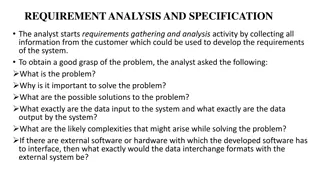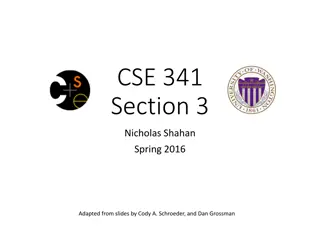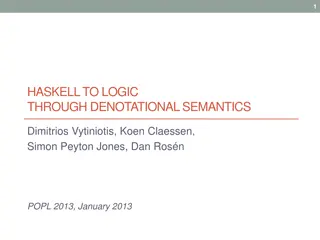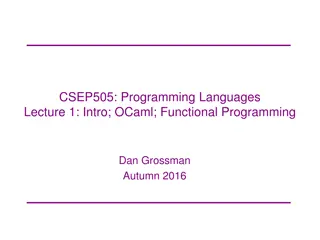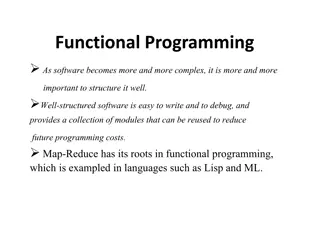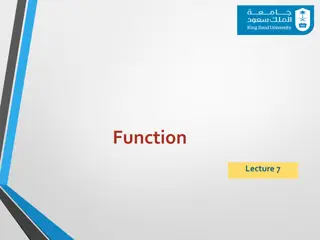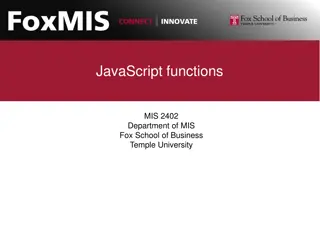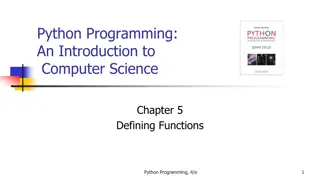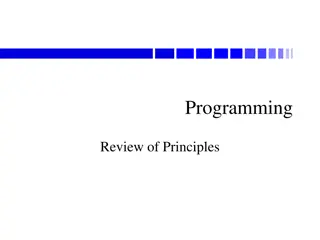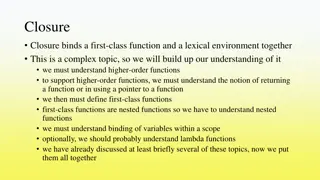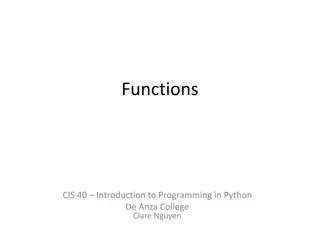Functional Programming with Higher-order Functions
Functional programming emphasizes the use of pure functions and higher-order functions to achieve benefits such as predictability, testability, and parallelization. By focusing on avoiding side effects and emphasizing function purity, developers can create more maintainable and scalable code. Learn about the differences between pure and non-pure functions, the impact of side effects, and the advantages of utilizing functional programming concepts in software development.
Download Presentation

Please find below an Image/Link to download the presentation.
The content on the website is provided AS IS for your information and personal use only. It may not be sold, licensed, or shared on other websites without obtaining consent from the author.If you encounter any issues during the download, it is possible that the publisher has removed the file from their server.
You are allowed to download the files provided on this website for personal or commercial use, subject to the condition that they are used lawfully. All files are the property of their respective owners.
The content on the website is provided AS IS for your information and personal use only. It may not be sold, licensed, or shared on other websites without obtaining consent from the author.
E N D
Presentation Transcript
Functional Programming & Higher-order Functions
Side effects A side effect is when something happens as a result of calling a function besides just returning a value. The most common side effect is logging to the console, via the built-in print() function. print(-2) A similar side effect is writing to a file: f = open('songs.txt', 'w') f.write("Dancing On My Own, Robyn") f.close()
Side effects vs. Return values def square_num1(number): return pow(number, 2) def square_num2(number): print(number ** 2) Which one has a side effect? The second function has a side effect, because it prints to the console. What data type do they each return? The first function returns a number, the second one returns None.
Pure vs. non-pure functions In programming, we can talk about pure vs. non-pure functions Pure function no side effects Non-pure function has side effects
Benefits of pure functions Pure functions provide several benefits The output of a function is only dependent on its input and is repeatable same input always means the same output can't influence or be influenced by external "state" This is great for math and mathematical proofs Functions can be tested and verified independent of one another which makes testing easier Code is easier to parallelize since it doesn't depend on anything else or affect anything else, it can be run in isolation
Functional Programming "Functional programming" is a paradigm that strives to achieve all the benefits of using pure functions in the execution of code. The chief characteristics of functional programming are: Programs are more declarative instead of imperative Functions as first-class objects & higher-order functions Limited or no side-effects Immutability of objects Recursion for control flow While many (or even most) modern languages support the functional programming paradigm, there are many languages where this it the core programming style e.g. Haskell, Erlang, Clojure, Common Lisp, and Scala
Why functional programming? Can be much easier to test and validate Code is often simpler and more modular Code written in a functional programming (FP) style is easier to parallelize FP style is heavily used in the machine learning and big data fields Many modern development frameworks are written in a functional style
Functional programming downsides More mathematically based and the vocabulary can be intimidating Programs can sometimes be harder to read and understand Can potentially require more time and/or memory space to execute Can't be used everywhere (database connections, servers, etc.) You really need to understand recursion
Characteristics of Functional programming Let's look at some of the characteristics of functional programming. We've already seen some of them in this class Functions as first-order objects Side effects and pure vs. impure functions (today) The new topics include: Declarative vs imperative programming (today) Higher-order functions (today and next time) Function composition (next time) Immutability of objects (soon) Recursion (after the midterm)
Declarative vs. Imperative programming
Declarative programming In imperative languages: A "program" is a description of computational processes The interpreter carries out execution/evaluation rules In declarative languages: A "program" is a description of the desired result The interpreter figures out how to generate the result
Domain-specific languages Many declarative languages are domain-specific: they are designed to tackle problems in a particular domain, instead of being general purpose multi-domain programming languages. Language Domain Regular expressions Pattern-matching strings Backus-Naur Form Parsing strings into parse trees SQL Querying and modifying database tables HTML Describing the semantic structure of webpage content CSS Styling webpages based on selectors Prolog Describes and queries logical relations
Display an image Declarative vs. Imperative Python from byuimage import Image HTML <html> <p>Hello</p> <img src="profile.jpg"> <html> print("Hello") img = Image("profile.jpg") img.show() The imperative language (Python) tells the computer what to do at each step to print a message and display an image. Import the image library, print the message, load the image, display it The declarative language (HTML) just tells that compute that it wants the message displayed and then an image. The language worries about how that is done.
Describing Functions def square(x): """Returns the square of X.""" return x * x Aspect Example A function's domain is the set of all inputs it might possibly take as arguments. x is a number A function's range is the set of output values it might possibly return. square returns a non-negative real number A function's behavior is the relationship it creates between input and output. square returns the square of x
Designing a function Give each function exactly one job, but make it apply to many related situations. round(1.23) # 1 round(1.23, 0) # 1 round(1.23, 1) # 1.2 round(1.23, 5) # 1.23 Don't Repeat Yourself (DRY): Implement a process just once, execute it many times.
Generalizing patterns with arguments Geometric shapes have similar area formulas. Shape 3 3 2 1 ?2 ?2 Area ?2
A non-generalized approach from math import pi, sqrt def area_square(r): return r * r def area_circle(r): return r * r * pi def area_hexagon(r): return r * r * (3 * sqrt(3) / 2) How can we generalize the common structure?
Generalized area function from math import pi, sqrt def area(r, shape_constant): """Return the area of a shape from length measurement R.""" if r < 0: return 0 return r * r * shape_constant def area_square(r): return area(r, 1) def area_circle(r): return area(r, pi) def area_hexagon(r): return area(r, 3 * sqrt(3) / 2)
What are higher-order functions? A function that either: Takes another function as an argument Returns a function as its result All other functions are considered first-order functions.
Generalizing over computational processes 5 ? = 1 + 2 + 3 + 4 + 5 = 15 ?=1 5 ?3= 13+ 23+ 33+ 43+ 53= 225 ?=1 8 5 4? 3 (4? 1)=8 8 35+ 8 99+ 8 8 3+ 195+ 323= 3.04 ?=1 The common structure among functions may be a computational process, not just a number
Functions as arguments def cube(k): return k ** 3 def summation(n, term): """Sum the first N terms of a sequence. TERM is a function that takes a single argument and returns a result. >>> summation(5, cube) 225 """ total = 0 k = 1 while k <= n: total = total + term(k) k = k + 1 return total
Locally defined functions Functions defined within other function bodies are bound to names in a local frame. def make_adder(n): """Return a function that takes one argument k and returns k + n. >>> add_three = make_adder(3) >>> add_three(4) 7 """ def adder(k): return k + n return adder View in PythonTutor
Call expressions as operator expressions 3 make_adder(1)( 2 ) Operator Operand func adder(k) make_adder(1) 2 1 make_adder(n) func make_adder def adder(k): return k + n return adder func adder(k)


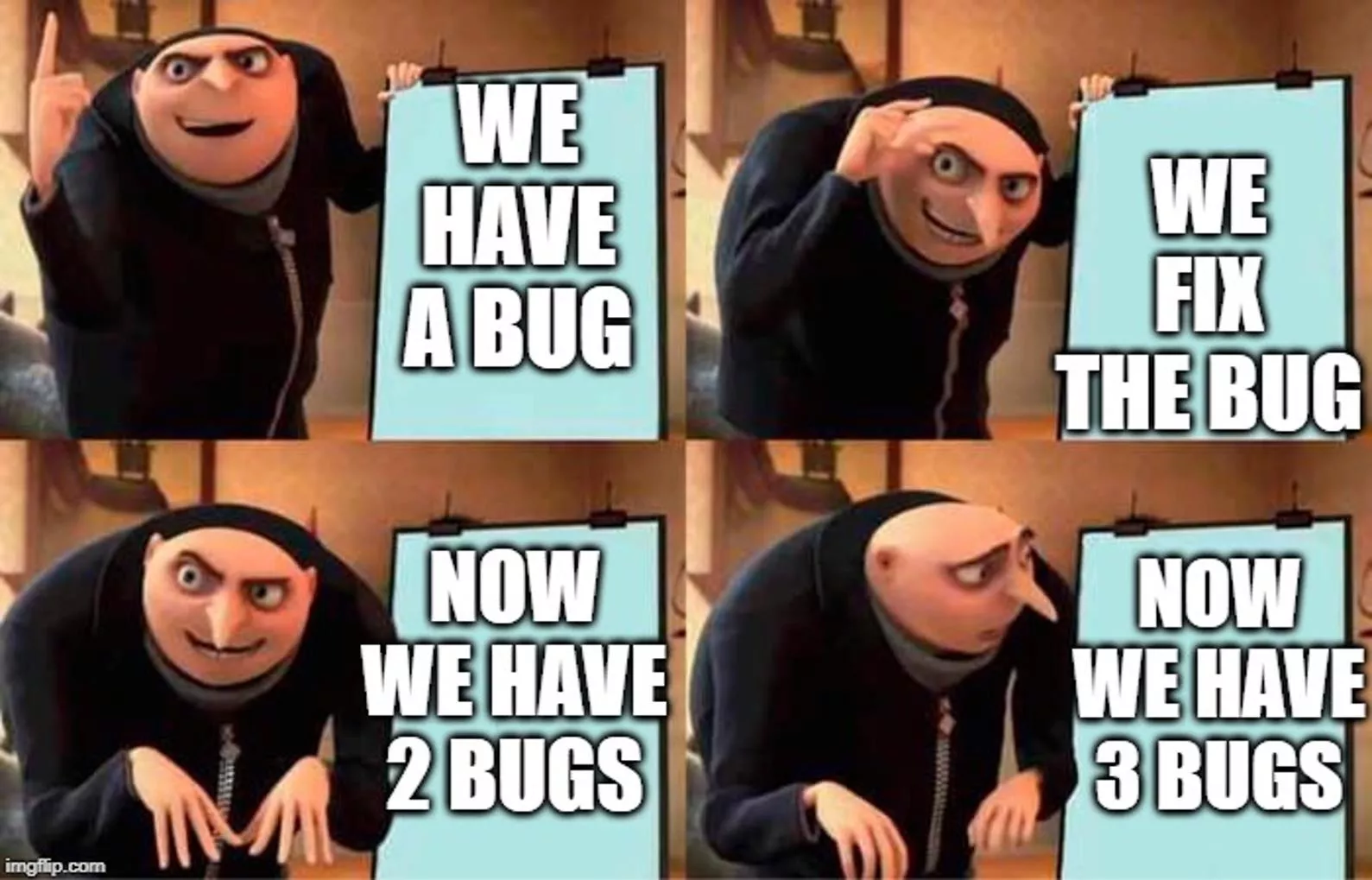
 undefined
undefined


